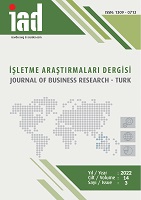Pandemi Sonrası Finansal Yeteneklerin Teknoloji Kabul Modeli Ekseninde İrdelenmesi: Katılım Finans Sektöründe Dijital Bankacılık Üzerine Bir Uygulama
Examination of Financial Capability After The Pandemic on The Axis of The Technology Acceptance Model: An Application on Digital Banking in The Participation Finance Sector
Author(s): Kayhan Ahmetoğulları, Nihat ArabacıSubject(s): Social Informatics, Financial Markets, ICT Information and Communications Technologies, Socio-Economic Research
Published by: İşletme Araştırmaları Dergisi
Keywords: Financial capabilities; Technology acceptance model; Digital banking; Participation finance;
Summary/Abstract: Purpose - The aim of this study is to evaluate the parameters that may be effective in the intention of participation bank customers in the Marmara Region to use digital banking, taking into account the pandemic concern, within the scope of technology acceptance model and financial capabilities. In other words, the effects of perceived usefulness, ease of use, trust, financial cost, use of digital banking, attitude towards financial service risk and financial advice on intention to use digital banking are evaluated at different levels of pandemic anxiety. Moreover, it is aimed to examine the effect of the intention to use digital banking on the level of use. Design/Methodology/Approach – In the research, the intention of participation bank customers in the Marmara Region to use digital banking is evaluated with quantitative patterned cross-sectional data. In the study, convenience sampling method was applied with data consisting of 334observations. ANOVA, exploratory factor, correlation and structural equation model analyzes were performed with the SPSS package program and the AMOS package program at the 5% significance level. Results - According to the exploratory factor analysis results, the extended technology acceptance model variables were confirmed. According to the results of the correlation analysis, a significant and positive relationship was found between all the variables included in the study. According to the results of the structural equation model, the structural equation model created for three different groups with low, medium and high pandemic anxiety is supported by the data obtained from bank customers. Discussion – In the study, it is tried to determine the digital banking usage intention and usage level based on the technology acceptance model and Sen's (1993) talent theory. In this context, perceived ease of use, usefulness, trust, financial cost advantage and pandemic anxiety played an important role in the model. The regulatory role of pandemic anxiety has been confirmed.
Journal: İşletme Araştırmaları Dergisi
- Issue Year: 14/2022
- Issue No: 3
- Page Range: 2270-2289
- Page Count: 20
- Language: Turkish

